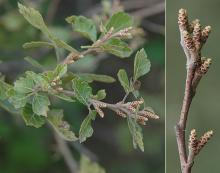Rhus aromatica
Common name:
Fragrant Sumac
Pronunciation:
roos a-ro-MAT-ik-a
Family:
Anacardiaceae
Genus:
Type:
Broadleaf
Native to (or naturalized in) Oregon:
No
- Broadleaf deciduous shrub, grows from 2-6 ft (0.6-1.8 m) high with a spread of 6-10 ft (1.8-3 m). Stems are pubescent; fragrant when bruised. Leaves alternate, compound, trifoliate (3 leaflets), the terminal leaflet is 4-8 cm long, cuneate, lateral leaflets rounded at the base, glossy green, may have orange to red or purplish-red fall color. Dioecious - male and female flowers on separate plants - but also may have unisexual and bisexual (perfect) flowers on the same plant. Flowers yellow, in clusters about 2.5 cm long, male in catkins and female in shot clusters of branch ends. Fruit is red, hairy (pubescent), subglobose, 6 mm diameter.
- Sun to part shade. Does best in acid, well-drained soil. Used as a fast cover for banks. Stems root when they touch the soil, hence good for bank stabilization.
- A low growing cultivar is 'Gro-Low', 2-3 ft high.
- Hardy to USDA Zone 3. Native range from Vermont and Ontario to eastern South Dakota, south to Texas and Florida.
- Rhus aromatica has been subdivided into several varieties. But since there are no consistent geographical patterns to variations in characteristics, some authorities suggest that Rhus aromatica is best considered a polymorphic species consisting of only two varieties, the eastern North American form, Rhus aromatica var. aromatica, and the western form, Rhus aromatica var. trilobata (Anderson, 2007). See Rhus trilobata.





